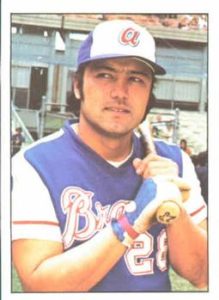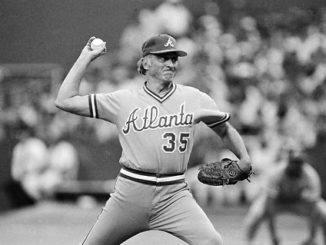 If you’ve noticed, as the numbers get lower, the Best Braves just keep getting better and better. We’ve crossed off several of our retired jerseys, and we’ve re-visited some real stars. It’s startling, then, to run across the black hole that is the #28, which has apparently been reserved for some of our least effective or most hated players. Let’s run through the list – and this even omits guys who didn’t wear it for the majority of a season. We’ve had 36 chances to get this right. We didn’t get it right.
If you’ve noticed, as the numbers get lower, the Best Braves just keep getting better and better. We’ve crossed off several of our retired jerseys, and we’ve re-visited some real stars. It’s startling, then, to run across the black hole that is the #28, which has apparently been reserved for some of our least effective or most hated players. Let’s run through the list – and this even omits guys who didn’t wear it for the majority of a season. We’ve had 36 chances to get this right. We didn’t get it right.
- Dutch Holland, 1932: +0.7 WAR – Dutch batted .295/.345/.397 in 169 plate appearances as #28. He’s probably going to make the shortlist.
- Marty McManus, 1934: +1.6 WAR – .276/.330/.372 in 472 plate appearances. He later managed in the All-American Girls Professional Baseball League.
- Larry Benton, 1935: -1.0 WAR – We’ll call Benton the first traditional #28 in Braves history. He had a 6.88 ERA for a team that went 38-115. For real, that was their record.
- Ken Weafer, 1936: -0.2 WAR – I can only assume his real name was Weaver, but by the time anyone had noticed, he was already out of baseball, having given up 4 runs in 3 career innings.
- Oliver Hill, 1939: +0.1 WAR – He batted only twice, but hit one double, making him, to this point, the 3rd most productive Brave to wear #28.
- Al Piechota, 1940-41: -0.7 WAR – The first Brave to accept multiple seasons of this hex, Piechota’s 5.75 ERA was easily the best yet among #28’s.
- Johnny Sain, 1942: -0.5 WAR – Wait a second, Johnny Sain is a legend! Right? While that’s true, Sain’s legend required a shedding of #28 before it could build. As #28, he allowed a 3.90 ERA and gave out as many free passes (BB+HBP) as strikeouts (68).
- Roy Talcott, 1943: -0.1 WAR – Talcott, who attended both Duke and Princeton, faced 5 career batters, giving up 1 hit, 2 walks, and 2 runs, before announcing, “I’m too smart for this bullshit” and permanently walking off the mound.
- Woody Rich, 1944: -0.2 WAR – Pitched 25 innings with a 5.76 ERA, striking out a whopping six batters.
- Steve Shermo, 1945: -0.2 WAR – Shermo had been mildly helpful as #14 the year before. As #28, he OPS-ed .516 and was soon out of the league.
- Morrie Aderholt, 1945: +0.9 WAR – Aderholt hit .333/.387/.431 in 111 plate appearances as #28, seeming to buck the trend. And despite that, those were the last 111 plate appearances in his career, presumably because the league believed he was the worst defensive 3B in existence.
- Earl Hersh, 1956: -0.1 WAR – Hersh went 3 for 13 in his career. Every hit was a double.
- Tommie Aaron, 1962-1965: -0.3 WAR – Batted .221/.295/.342 in his 3 years as #28. Could never quite convince folks he and brother Hank were from the same bloodline.
- Jesse Gonder, 1965: -0.1 WAR – Deemed disposable by the 1965 Mets, a 50-112 ballclub, Milwaukee bizarrely handed him 57 plate appearances.
- Ron Reed, 1966: +0.1 WAR – Reed was an All-Star and World Series champion… after he switched numbers. He wasn’t bad as #28, but only pitched 8 1/3 innings. He was the 15th player to wear #28, and only the 5th to produce a net positive WAR.
- Jim Beauchamp, 1967: -0.1 WAR – Beauchamp went 0 for 3 with one RBI on a sacrifice fly. By the time he became a bench coach for Atlanta later on, he wore #26.
- Mike Lum, 1967-1975, 1980-1981: +5.9 WAR – Mike Lum is the best Brave to wear #28, folks. He spent 12 years wearing the number for the Braves, only hitting .250/.321/.371, but hey, 12 years. He played more games than any Hawaiian born player in history (still), and you can read more about Lum here.
- Pablo Torrealba, 1976: +0.3 WAR – Wow, a bona fide contributor who wore #28. Not a compellingly good one, but a contributor nonetheless, going 0-2 with 2 saves and a 3.57 ERA across 53 innings.
- Adrian Devine, 1978: -0.4 WAR – Devine would be pretty helpful in 1979, after he switched to #38. As #28, he had a 5.92 ERA.
- Larry Whisenton, 1981-1982: +0.1 WAR – As #28, Whisenton hit .236/.343/.392, and despite having his best season in 1982 at age 25, never played again. Curse of #28 strikes again.
- Gerald Perry, 1983-1989: -0.4 WAR – Perry was mildly helpful in 1987 and 1988, where if you glanced at his statline, you’d think, “Hey, this guy’s a pretty helpful 2B or CF.” And then you’d see that he plays 1st base, and suddenly slugging .400 isn’t quite as noteworthy. He was a 1988 All-Star because the team was required to send one.
- Joe Hesketh, 1990: -0.3 WAR – There’s a chance Hesketh wore #38 more than #28 that season, but with a 5.81 ERA, Braves fans just wanted to him to wear a different jersey altogether.
- Greg Myers, 1999: +0.1 WAR – Acquired as an extra catching body for the stretch run, Myers provided ok defense and batted .222/.337/.333.
- John Hudek, 1999: -0.2 WAR – As a rookie in 1994, Hudek became the first pitcher to make an All-Star game before earning his first MLB win. 5 years later, he had a 6.48 ERA for the Braves in what would ultimately be his final season.
- Ryan Langerhans, 2002: -0.1 WAR – Langerhans wore #28 for his MLB debut. He went 0 for 1. He never wore #28 in a game again.
- Darren Bragg, 2002-2003: -0.5 WAR – Bragg batted .257/.329/.350 in his 2 years on the Atlanta bench and managed to go 0 for 8 in two NLDS losses.
- Sam McConnell, 2004: 0.0 WAR – Baseball Reference says this guy made 10 appearances for the 2004 Braves. Baseball Reference is clearly lying.
- Matt Childers, 2005: 0.0 WAR – Matt Childers, or as he’s better known, the Sam McConnell of the 2005 Braves.
- Joey Devine, 2005-2006: -0.4 WAR – 11.1 innings, 29 baserunners, 14 runs. Congrats – you managed to not even be the best Devine to wear #28, and the other one’s ERA was nearly 6.
- Bob Wickman, 2006-2007: negative infinity WAR – I don’t care if he had a 2.84 ERA and 38 saves in Atlanta, I’ll shut down this website before I ever give this turd any kind of accolade.
- Brandon Jones, 2007-2009: -0.4 WAR – I always thought Jones had the tools to be better. The tool he didn’t have was the wisdom to select an uncursed uniform number.
- Rick Ankiel, 2010: +0.3 WAR – We’ll always have that NLDS homer.
- Julio Lugo, 2011: -0.3 WAR – A brief pause in our action so we can recognize Lugo for scoring on the most “whatever, let’s go home” call in MLB history.
Even Lugo couldn’t believe it. And the best part of that is that the batter, reliever Scott Proctor, goes face first into the grass after about 3 steps out of the batter’s box. The whole thing was wildly hilarious.
Lugo batted .136/.208/.136 while with the Braves, so it’s anyone’s guess as to how he was on base to begin with.
- Paul Maholm, 2013: -0.2 WAR – Remember 2012, when Maholm was kind of helpful? Yeah, he wore #17 that year. 2013 was the year Maholm allowed a 4.41 ERA and was generally uninspiring.
- Joey Terdoslavich, 2015: 0.0 WAR – That .254 OBP isn’t doing a lot for me. It also didn’t do much for other MLB teams, as Terdoslavich has yet to return to the majors.
- Hector Olivera, 2015-2016: -0.2 WAR – Is there a more perfect, emphatic punctuation on this list of war crimes than Olivera? Atlanta should retire #28 in Olivera’s (dis)honor. Instead of hanging it on the stadium façade, they should purchase a rocket from Elon Musk and fire the #28 into the heart of the sun.
36 players have worn this jersey. They have combined for 4.4 Wins Above Replacement. For a jersey bookended by the likes of John Smoltz and tomorrow’s product of the Tom Emanski school of hitting, that is utterly pathetic.
With all these prospects coming forward in the next few years, keep your eye out for their jersey assignments, and hope they escape whatever voodoo comes with #28. I’m not a superstitious guy (I’m not even a little stitious), but I’m pretty sure this number just spells automatic failure and will do so for the rest of eternity.
And frankly, with Dale Murphy’s #3 displayed prominently in the stadium, I have no desire to put the number 28 anywhere in its vicinity whatsoever.




Leave a Reply